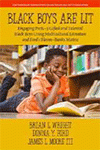
Black Boys are Lit
Engaging PreK-3 Gifted and Talented Black Boys Using Multicultural Literature and Ford’s Bloom-Banks Matrix
By:
Brian L. Wright, The University of Memphis
Donna Y. Ford, Ohio State University
James L. Moore III, The Ohio State University
A volume in the series: Contemporary Perspectives on Multicultural Gifted Education. Editor(s): Donna Y. Ford, Ohio State University. Malik S. Henfield, Loyola University Chicago.
Published 2021
This book of matrices with Black boys as the main character is designed to help gifted and talented education teachers leverage Black boys’ identities to inform and shape how they plan and deliver curriculum and instruction and manage the multicultural, democratic, and culturally responsive classroom. Ford and colleagues (2005) spoke to the notion of and need for ‘self-reflective instruction.’ We argue that all teachers must want to and learn how to legitimize the “everyday” experiences that are learned and cultivated in the homes and communities of Black boys, and how these experiences shape their self-identities and contribute to agency (Wright, Counsell, & Tate 2015). We, therefore, advocate for the rethinking of literacies by repositioning White-centered texts that often reflect and represent power and privilege toward centering the brilliance of Black identities of Black children in general, Black boys in particular.
Black boys (of all ages) want to and need to physically see positive images of themselves in books reflected at them. This representation, we argue, has the potential to become an example of a compelling counter-narrative to the history of the “all-White world” (Larrick, 1965) of children’s books that only presented Black characters as “objects of ridicule and generally inferior beings” (Sims Bishop 2012, p. 6). When Black boys see themselves portrayed visually, textually, and realistically in children’s books, vital messages of recognition, value, affirmation, and validation are conveyed. Recognition of the sociocultural contexts in which they live is celebrated.
Books for and about Black boys must be rigorous, authentic, multicultural, and developmentally appropriate to allow them to synthesize what they have read, heard, and seen during literacy instruction in authentic and meaningful ways. Multicultural books must introduce children to information about the values of justice, fairness, and equity. Developmentally appropriate books should vary with and adapt to the age, experience, and interests of gifted and talented Black boys to allow them the opportunity to demonstrate critical thinking, textual analysis skills and convey conceptual knowledge. These stories must expose Black boys to culturally relevant counter stories -- stories that counteract the dominant discourse that has primarily depicted Black boys as “at risk” versus placed at risk; “without hope” versus hopeful; or “out of control and dangerous” (Tatum, 2005, p. 28) versus developing self-control like all other children (Wright et al., 2018).
CONTENTS
PREFACE: Why a Book About Gifted and Talented Black Boys and Literature? The Authors Share Their Stories. Acknowledgments. CHAPTER 1: Introduction. CHAPTER 2: The More We Know, the Less We Make Up About Black Boys. CHAPTER 3: Mirror Books Versus Window Books: Reflection Matters. CHAPTER 4: Banks’ Multicultural Curriculum Model and Bloom’s Taxonomy. CHAPTER 5: Ford’s Bloom–Banks Matrix: An Overview. CHAPTER 6: Authentic Children’s Books Promote Identity and Agency. CHAPTER 7: Applying the Ford Bloom–Banks Matrix: Books With Black Boys as the Protagonist. References. About the Authors.
-
Paperback978-1-64802-747-5
Web price: $45.04 (Reg. 52.99)
-
Hardcover978-1-64802-748-2
Web price: $80.74 (Reg. 94.99)
- eBook978-1-64802-749-9

- EDU009000 - EDUCATION: Educational Psychology
- EDU020000 - EDUCATION: Multicultural Education
- EDU007000 - EDUCATION: Curricula
-
 A Second Helping of Gumbo for the Soul
More Liberating Stories and Memories to Inspire Females of Color
A Second Helping of Gumbo for the Soul
More Liberating Stories and Memories to Inspire Females of Color
-
 Gumbo for the Soul
Liberating Memoirs and Stories to Inspire Females of Color
Gumbo for the Soul
Liberating Memoirs and Stories to Inspire Females of Color
-
 Gumbo for the Soul III
Males of Color Share Their Stories, Meditations, Affirmations, and Inspirations
Gumbo for the Soul III
Males of Color Share Their Stories, Meditations, Affirmations, and Inspirations
-
 Identifying, Preventing and Combating Bullying in Gifted Education
Identifying, Preventing and Combating Bullying in Gifted Education
-
 Latinx College Students
Innovations in Mental Health, Advocacy, and Social Justice Programs
Latinx College Students
Innovations in Mental Health, Advocacy, and Social Justice Programs
-
 Reflections on People, Policy, and Practices in Curriculum History
Reflections on People, Policy, and Practices in Curriculum History
-
 Understanding the Intersections of Race, Gender, and Gifted Education
An Anthology By and About Talented Black Girls and Women in STEM
Understanding the Intersections of Race, Gender, and Gifted Education
An Anthology By and About Talented Black Girls and Women in STEM

